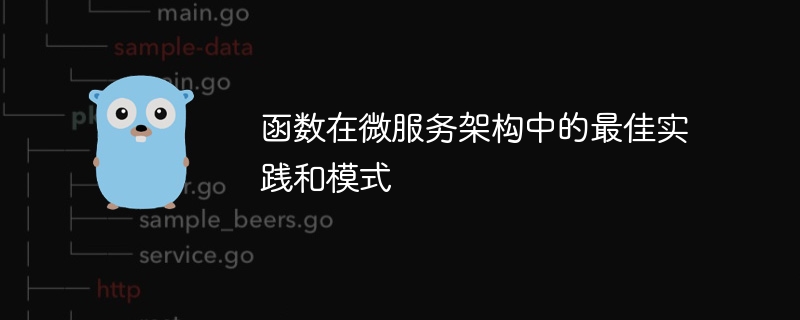Home >Backend Development >Golang >Best practices and patterns for functions in microservice architecture
Best practices and patterns for functions in microservice architecture
- WBOYWBOYWBOYWBOYWBOYWBOYWBOYWBOYWBOYWBOYWBOYWBOYWBOriginal
- 2024-04-12 11:48:02565browse
In a microservice architecture, functions have the advantages of scalability, loose coupling, and maintainability. Best practices include keeping functions small and focused, using asynchronous processing, and focusing on idempotence. Applicable patterns include stateless functions, stateful functions, Saga pattern, CQRS and event sourcing. In practical cases, the order processing microservice can use the stateless function pattern to store order information in the database to achieve a scalable, loosely coupled and maintainable system.

Best practices and patterns of functions in microservice architecture
In microservice architecture, functions are used to implement service logic Lightweight components, they have the following advantages:
- Scalability: functions can be elastically expanded according to demand.
- Loose coupling: functions are independent of each other and have no shared state.
- Maintainability: Functions are easy to develop and maintain.
Best Practices
- #Keep functions small and focused: Keep functions moderately long and focused on a single task.
- Use asynchronous processing: For long-running tasks, use asynchronous processing to avoid blocking.
- Handling errors: Define a clear error handling mechanism and log errors.
- Focus on idempotence: Ensure that functions can be called multiple times without side effects.
- Limit concurrency: Set concurrency limits to prevent function overload.
Pattern
- Stateless functions: Functions without state are easy to extend and manage.
- Stateful functions: Stateful functions can store data, but they need to be managed carefully to avoid state loss.
- Saga Mode: Coordinate multiple functions to complete distributed transactions.
- Command Query Separation (CQRS): Separates read and write operations to improve concurrency.
- Event source: Records event streams to provide data consistency and auditability.
Practical case
Consider an order processing microservice, which includes the following functions:
- Create an order: Create a new order and store it in the database.
- Update order status: Update the status of the order, such as shipped or canceled.
- Get orders: Get order information from the database.
In order to implement these functions, you can use the stateless function pattern. Functions will remain lightweight and focused on a single task, such as creating or updating an order. State information will be stored in the database, ensuring data consistency and durability.
By following these best practices and patterns, you can effectively use functions in a microservices architecture to achieve scalable, loosely coupled, and maintainable systems.
The above is the detailed content of Best practices and patterns for functions in microservice architecture. For more information, please follow other related articles on the PHP Chinese website!
Related articles
See more- Detailed explanation of examples of service registration and discovery of 'microservices'
- Mini Program I18n Best Practice Cases
- How to deploy and manage services in microservice architecture?
- How to ensure data consistency in microservice architecture?
- How to use PHP for basic microservice architecture design

